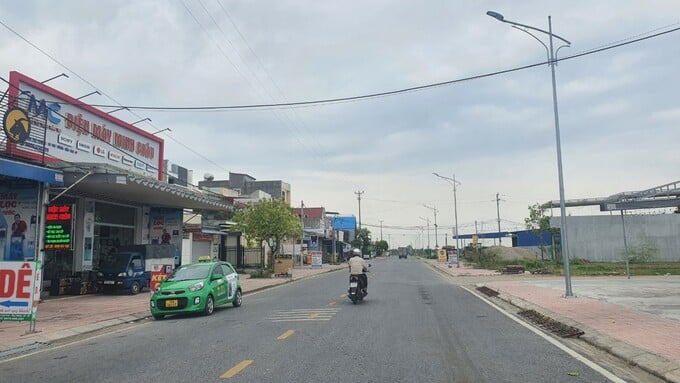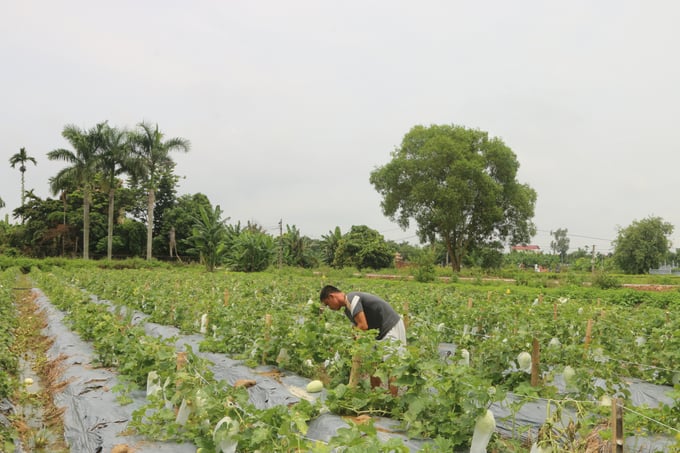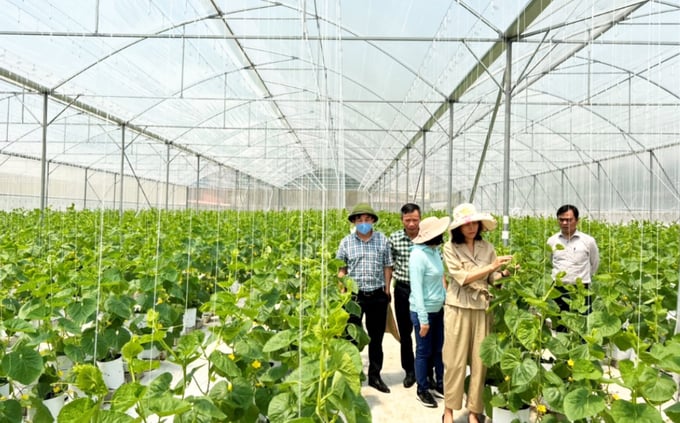November 27, 2025 | 22:20 GMT +7
November 27, 2025 | 22:20 GMT +7
Hotline: 0913.378.918
November 27, 2025 | 22:20 GMT +7
Hotline: 0913.378.918

The new model countryside road in Thuy Huong commune, Kien Thuy district. Photo: Dinh Tung.
With the aim of improving rural residents’ livelihoods in line with new rural construction, the Resolution of the Hai Phong People's Council also sets the orientation for agroproduction development, which is "Building model new countryside associated with effective implementation of agricultural restructuring and rural economic development - improving rural people’s life both physically and mentally". Localities are making great efforts to carry out this policy.
People in Kien Thiet commune, Tien Lang district used to grow only two rice crops a year, earning meager income, so life was difficult all year round. Later some households received training on the rice – melon and rice – chili intercropping model from Hai Phong Agricultural Extension Center. Realizing that farmers grew muskmelon, honeydew melon, and chili effectively on the ground of just-harvested rice crops, the households boldly followed this method.
Melons can be harvested after 55-60 days counting from the sowing date, helping farmers earn VND 110-150 million/crop on average. Having experienced the model's effectiveness, now farmers in Kien Thiet commune are switching to growing honeydew melon. Many families have achieved great success thanks to applying the two rice crops – one melon crop.

People have switched from rice farming to effective melon growing models. Photo: Dinh Tung.
Meanwhile, new rural construction in Kenh Giang commune, Thuy Nguyen district is taking place with great enthusiasm. The restructuring of crops is also directed very clearly.
Implementing criterion 13.3 in new rural construction, Song Gia Investment & Development Cooperative has implemented a hi-tech melon growing model in A2 Trai Kenh village (Kenh Giang commune) with a scale of 6,800 m2, in which 3,300 m2 of land is utilized to plan muskmelon and Bach Ngoc honeydew melon according to organic farming methods.The cooperative’s hi-tech agroproduction model applies a standard procedure that is strictly controlled from seed selection, growth monitoring, watering until the melons are harvested.
"Growing melons in polyhouse has many advantages in terms of crop management. The polyhouses help to cover rain and prevent insects from entering, reducing the overall production costs due to less use of pesticides. In the near future the cooperative will continue to organize safe production in order to meet VietGAP and organic standards. The production process will associate with branding, traceability, and production linkages and product underwriting between farmers and businesses. Our goal is to increase income and value of agroproduction in the area," said Nguyen Thi Thuy Ha, director of Song Gia Cooperative.

Hai Phong Agricultural Extension Center always accompanies people on the path of developing crop restructuring models. Photo: Ha My.
Hai Phong has set a goal that by 2025 there will be 137 communes that meet the standards stated in the Criteria for Model Rural Communes and complete the criteria for advanced new rural areas according to the Central Government’s regulations. When this goal is completed, at least 70% of the main roads in communes from the district roads to the commune center and inter-commune roads will be paved with asphalt at least 9m wide, have sidewalks or curbs, drainage ditches and electricity for residential lighting.
In parallel with building new rural areas, Hai Phong's agricultural sector will continue to promote agricultural restructuring and economic restructuring in the direction of developing concentrated, large-scale commodity agroproduction along the value chain. The development of agroproduction will proceed in line with tourism and new rural construction. Advanced technology, high technology, mechanization will be fully utilized to improve added value, productivity, quality and competitiveness of products in domestic and export markets.
On the other hand, Hai Phong will accelerate the implementation of land accumulation and concentration policies for large-scale agricultural development, convert inefficient rice land to produce agro-products of high economic value, and build raw materials areas to supply agro-products for processing and hi-tech agricultural zones.
Hai Phong strives to achieve a number of goals by 2025: GRDP growth in agriculture, forestry and fishery reaches 2.0%/year; production value growth reaches 1.7%/year; the structure of agriculture - forestry - fishery production value is 55.90% - 0.20% - 43.90%; the added value per unit of agricultural land is VND 180 million/ha (current price); the value of crop production reach VND 245 million/ha; the rate of crop production area applying advanced and high technologies reach 62.4%.
Translated by Samuel Pham

(VAN) According to Mr. Vo Minh Thanh, Director of the Tay Ninh Department of Agriculture and Environment, Resolution 57 has created a new development pathway for the locality, shifting from traditional toward modern agriculture.
/2025/11/26/4909-2-154329_878.jpg)
(VAN) Pearl grouper farming in HDPE cages not only delivers economic efficiency but also contributes to protecting the environment, creating jobs, and promoting marine-based experiential tourism.

(VAN) The model of making a living under the forest canopy through the agroforestry system in Van Son commune, Bac Ninh province, is expected to generate an annual income of approximately VND 30 million/ha.

(VAN) Many enterprises in Can Tho are harnessing natural energy and reducing greenhouse gas emissions in their production processes, thereby contributing to the promotion of a sustainable green transition.
/2025/11/24/3536-2-112800_176.jpg)
(VAN) Dong Nai now has tens of thousands of hectares of forests certified for sustainable management, and this area will continue to be expanded in the coming period.

(VAN) Vinh Ha hamlet (Dai Xuyen commune, Hanoi) is shifting away from small-scale farming as households adopt bioscurity into their breeder chicken models.

(VAN) Heavy rains make aquatic species more vulnerable to disease. Proactive water management and high-tech systems help farmers prevent outbreaks and protect yields.